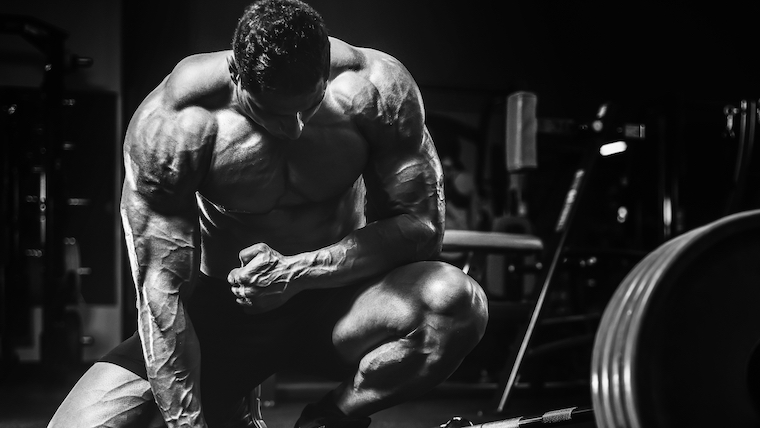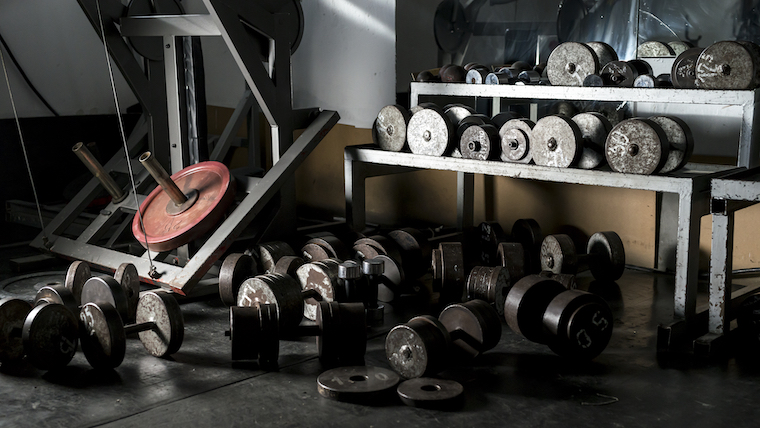There’s the idea of a “true bodybuilder gym.” They are known for having it all: a bajillion machines, handles, gadgets, weights that run heavy, and tons and tons of space to strut, pose, and generally take up a lot of physical — and charismatic — space. These are places where big bodies bang and clang big weights, where no one apologizes for throwing up poses to inspect their progress. In short, the classic idea of a bodybuilder gym is, in a way, “psychically loud.”
Think of legendary spaces like eight-time Mr. Olympia Ronnie Coleman’s beloved MetroFlex in Arlington, TX, the Montanari Brothers’ Powerhouse Gym in North Haven, CT, or seven-time Mr. Olympia Arnold Schwarzenegger’s go-to Gold’s Gym in Venice Beach, CA — training spaces gritty and flashy in equal measure. However, with social media commandeering the banner of aesthetics, the fear of missing out (FOMO) in those home-grown gyms where bodybuilding culture developed remains.
Although predicting gym trends can be daunting and best left to analysts, it would be inflammatory and premature to decry “the extinction of true bodybuilder gyms is nigh!” However, there is no denying that their market share seems to hold less and less favor in an industry dominated by corporate franchise gyms like Crunch, Planet Fitness, Edge, and Orange Theory. Bodybuilder-oriented culture is not what the industry favors. This places these beloved gyms in a micro-category that their business model may not have been designed to sustain.

[Related: The Lat Pulldown vs. the Pull-Up — Which Is Better for Back Gains?]
Editor’s Note: This article is an op-ed. The views expressed herein and in the video are the author’s and don’t necessarily reflect the views of BarBend. Claims, assertions, opinions, and quotes have been sourced exclusively by the author.
The Downward Trend
According to The Global Health and Fitness Association (IHRSA), as of 2019, the USA has the highest volume of gym memberships globally, nearly six times more than Germany in second. The USA also has over 10,000 more gyms than the next highest country (Brazil). (1) There was massive gym industry growth following the first several years of the COVID-19 pandemic (including a renewed trend on Wall Street towards investment in chain brands). (2) However, that trend did not seem to reflect similarly on big muscle warehouse gyms that were the foundation of bodybuilding gym culture.
For any gym to survive, it needs to make money. The more niche the gym’s focus (e.g., bodybuilding), the more challenges arise for the owner to keep the lights on. National “all-purpose gyms” like the aforementioned corporate facilities can better sustain ebbs and flows of membership revenue due to the inherent security of being a franchise. However, local bodybuilding gyms don’t often have the same luxury.
Building Revenue
Gyms generate revenue primarily through memberships — primarily new memberships. Ironically, a gym with disloyal members is still likely to survive. According to CreditDonkey, only about 23 percent of people who buy gym memberships use them consistently, and more than three-fourths of gym members bail within their first year. That’s not intrinsically negative. Gyms often need significantly more members than they could physically serve to remain profitable. Similarly, new membership sales and pay-per-visit can generate more money than loyal members who pay a monthly fee.
Loyal bodybuilders could be a losing investment for most gyms. Bodybuilders, as a class of gym-goers, are more likely to remain consistent and perhaps even be forgiving of a gym that lacks amenities offered by corporate gyms to maintain a hardcore-bodybuilding-mecca vibe — meaning going against what has consistently proven to grow larger-scale gyms.

[Related: Bodybuilding Lore Addressed: Can You Actually Target Your Inner Chest?]
While bodybuilding training is not going anywhere, we are in a moment at the dawn of 2023 when bodybuilding gym culture represents a niche in the industry. One that is negligible for business concerns and could represent an unstable business model. The bodybuilder gyms that remain open have found a sweet spot of low overhead and high population with a “destination gym experience” branding (e.g., the legendary gyms mentioned above).
A gym that encourages heavy lifting, loud and demonstrative behavior (such as posing right in the middle of the weight floor) is likely to generate a hyped-up, bodybuilder-centric mood that is more likely to secure competitors, fans, and appreciators of the sport’s culture rather than the average gym goer looking to achieve a new year’s fitness resolution.
How Bodybuilding Gyms Can Thrive
A key factor for the future of bodybuilder gyms may be that bodybuilding-centric mood — beholden to exude its brand via social media. The bodybuilding culture has always, always, always relied on its influence upon pop culture to thrive. Think of how action and superhero movies look like men’s physique competitors.
Ever notice how casual fashion is eager to exaggerate and emulate a V-tapered look that hints at muscular development? Ever notice how social media’s body ideals for men involve swole pecs and chiseled abs? All the ways the bodybuilding aesthetic creeps into pop culture plays a role in securing its relevance. As such, not training like a bodybuilder could produce a high degree of FOMO from normal gym-goers who ogle their Instagram feeds of chiseled physiques — those results seem intentionally designed to be socially appealing.

[Related: Crack the Code on New Leg Gains With the Hack Squat Machine]
Bodybuilding Culture or Bodybuilding Is Culture?
An aesthetic body is a social asset. It extends personal charisma beyond just cosmetic style. Bodybuilding – the pursuit of creating more rare or exotic designs of a muscular physique – cranks up the volume on that charisma. That’s maybe why bodybuilding can become an art form for the common person — a type of performance art that merges social charisma with physical shape. As such, any gym that encourages its members to achieve or expand upon that charismatic social asset becomes more desirable to the bodybuilder than other options.
We must reconsider what a bodybuilder regards as a gym’s advantages versus the broader industry trends. For example, while 50 percent of gym-goers say they hold a membership based on the gym’s location, bodybuilders likely fall in the other 50 percent. After all, bodybuilders are more likely to bring their business to a gym they saw on social media — an aggressive “warehouse dungeon” filled with jacked upper bodies and seas of equipment — even if it’s proximally farther away, just because it has that brand (i.e., clout) of a “true bodybuilder gym.”
[Read More: The Best Upper Body Exercises and Workouts]
What predictions can we make for the fate of the small niche of gyms still catering to the bodybuilding culture? None with certainty. The gym industry grew in 2022 and is poised to grow further in 2023. The trend suggests the industry will further focus on the non-niche, broad-interest categories catered to by corporate franchises. Does this spell the end of the legendary musclehead warehouses that are central to sustaining bodybuilding culture? Most likely not if they can reinvent themselves to become “destination gyms” like those we already know by name.
References
- Andre, L. (2021). 87 Gym Membership Statistics You Must Learn: 2022 Cost, Demographics, and Market Share – Financesonline.com. Retrieved 5 January 2023, from https://financesonline.com/gym-membership-statistics/
- Wirz, M. (2023). PE bets on gym chains getting back in shape. Retrieved 5 January 2023, from https://www.penews.com/articles/pe-bets-on-gym-chains-getting-back-in-shape-20220324
Featured image via Shutterstock/ALL best fitness is HERE